Choosing the right paring knife can be an overwhelming experience. Although the knife you choose comes down to personal preference, we break down what to look for in a paring knife to make the process easier. This article will cover the use cases, various paring knife shapes, the blade material, the handle, finding the right balance and hardness in your knife, and the most reliable knife brands. This is the one guide you need to read to know what’s right for you.
Read now: The 5 best paring knives – 2023 Reviews
What is a paring knife?
A paring knife, also known as a peeling knife, is a short chef knife that is around 2.5 – 4 inches in length. Its smaller size makes cutting, chopping, and other various kitchen tasks more precise.
A paring knife is a versatile kitchen knife that makes things like mincing herbs, shucking oysters, deveining shrimp, as well as peeling, slicing, and coring fruits and vegetables, an absolute breeze. You can use the knife on a chopping board or in your hand, depending on the size of the blade and the use case. However, the short blade is not suitable for heavy work on meat, such as slicing, carving, or deboning. It’s also not suitable for slicing bread or cutting hard and large vegetables like squash or watermelon.
Do you really need a paring knife?
A paring knife is crucial for any chef because it’s the perfect tool for in-hand work – tasks that involve you holding the object you’re cutting instead of using a cutting board. It’s also very convenient for small jobs where you need precision without the use of a large chef knife. You might be thinking that the use cases of a paring knife are similar to a peeler, but while a peeler can remove the skin on hard fruits like an apple, it will puree a tomato or peach. The key differentiator of a paring knife is that it has an extremely sharp blade that will allow you to be in full control to get precise cuts. Considering the various use cases for a paring knife, they are worth including in the kitchen to add to your cooking experience.
How to hold and use a paring knife?
Having a good grip on your paring knife is essential because you need to have complete control over the blade. Most paring knives are designed to fit the human hand snugly to provide precision in your cut and comfort in your grip. When peeling fruits and vegetables, you should be able to hold the handle in your fist and use your index or thumb to guide the blade on the spine. Slowly move the blade toward your body, cutting the skin of the ingredient. To ensure you’re not cutting more than just the peel, move lightly when using a paring knife. While using a paring knife on a cutting board, hold the blade with your fist but direct the blade with your wrist, not the heel of your hand like you would do for larger knives.
How to choose the best Paring knife for you?
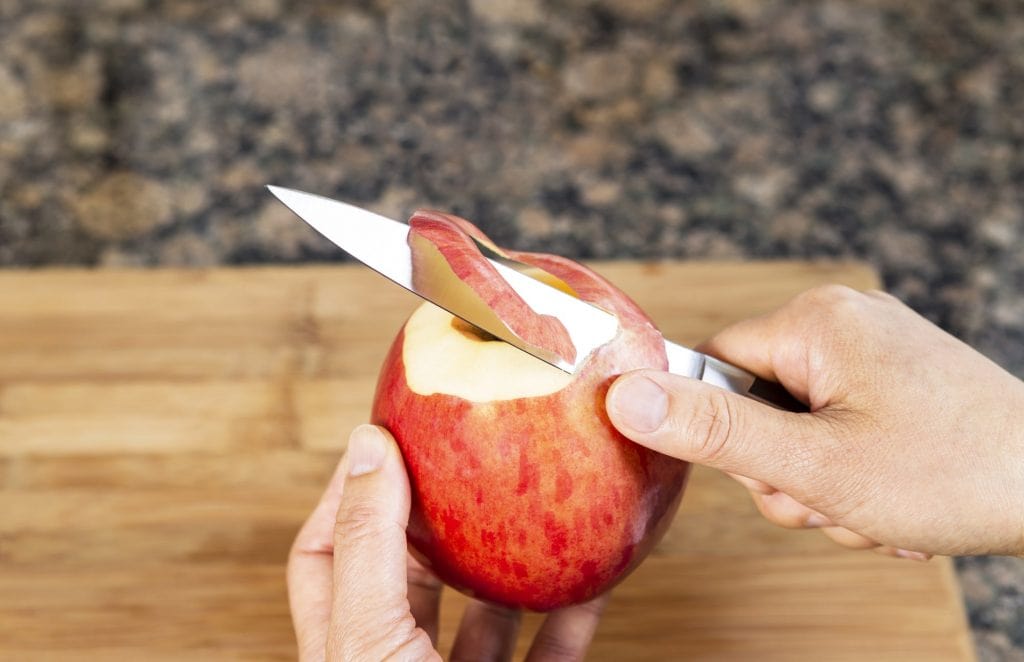
Price – How Much Does A Paring Knife Cost?
Paring knives can cost anywhere from $10 – $180 depending on the material, tang, quality, handle, and grip. However, choosing if you want a budget-friendly or higher-end knife depends on your use case. If you’re looking for something to add to your collection for occasional use, going with a blade that may dull quicker overtime may be okay for you. If you plan to use this knife daily, going for a knife that is extremely sharp and easy to care for may be more beneficial in the long run. There is a variety of paring knives on the market at various price points to cater to your needs.
The Paring Knife’s Blade
The shape of your paring knife blade is important because it affects what you are able to use your knife for. The shape affects your ability to have full control as well as how precise you can make your cutting lines. The sharpness also affects precision so picking a knife that is sharp allows for precise cuts with minimal effort.
Blade Shapes – What shape does a paring knife have?
A paring knife is shorter than a chef knife and is either flat or slightly curved with a rounded or sharp tip. The shape of the blade affects the use cases of the knife. We’ll elaborate more below on the 4 most common blade types and what the best use case and possible disadvantages are of each style.
Spear point/spear tip (Also called “European” or “Classic”) paring knife
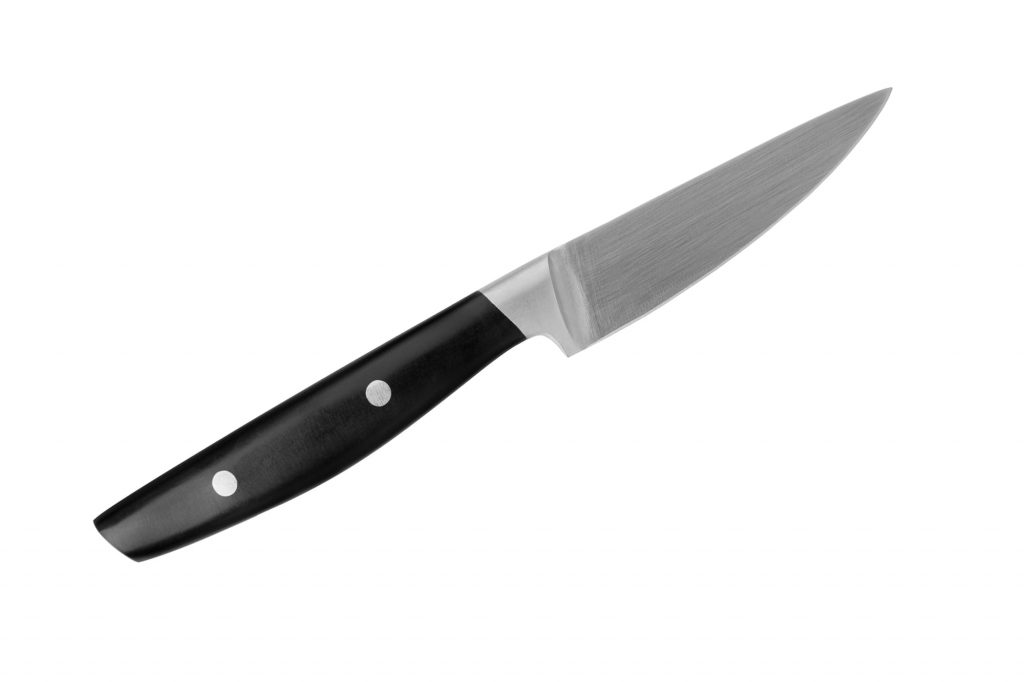
A spear point paring knife is also called a European or Classic paring knife. This blade shape is the most common because it has a smooth, short, and outwardly curved blade that enables chefs to apply less pressure and let the knife do the work. Both edges of the knife rise and fall equally and they can be single or double-edged. Some spear point knives can come with a serrated edge that allows the cook to use a sawing motion, but not all of them are serrated.
The best use case for a spear point knife is for peeling and coring fruits and vegetables. It’s a multi-purpose knife that is good for most tasks and the sharp tip makes it easy to pierce and stab food while maintaining control. This knife is perfect for anyone looking for a good balance between piercing and slicing. It combines the sharp tip of a dagger with the strength of a drop point blade. It’s a hybrid knife created for functionality.
However, the shape of this knife creates a small cutting edge, “belly”, for slicing and some cheaper versions of the knife may be too flimsy for more heavy-duty tasks. It’s also harder to maneuver around round foods because it has less precision than a blade on the bird’s beak paring knife. Overall, this is the best versatile knife that can perform a wide variety of tasks and is perfect if you’re only looking to purchase one paring knife.
Bird’s beak paring knife
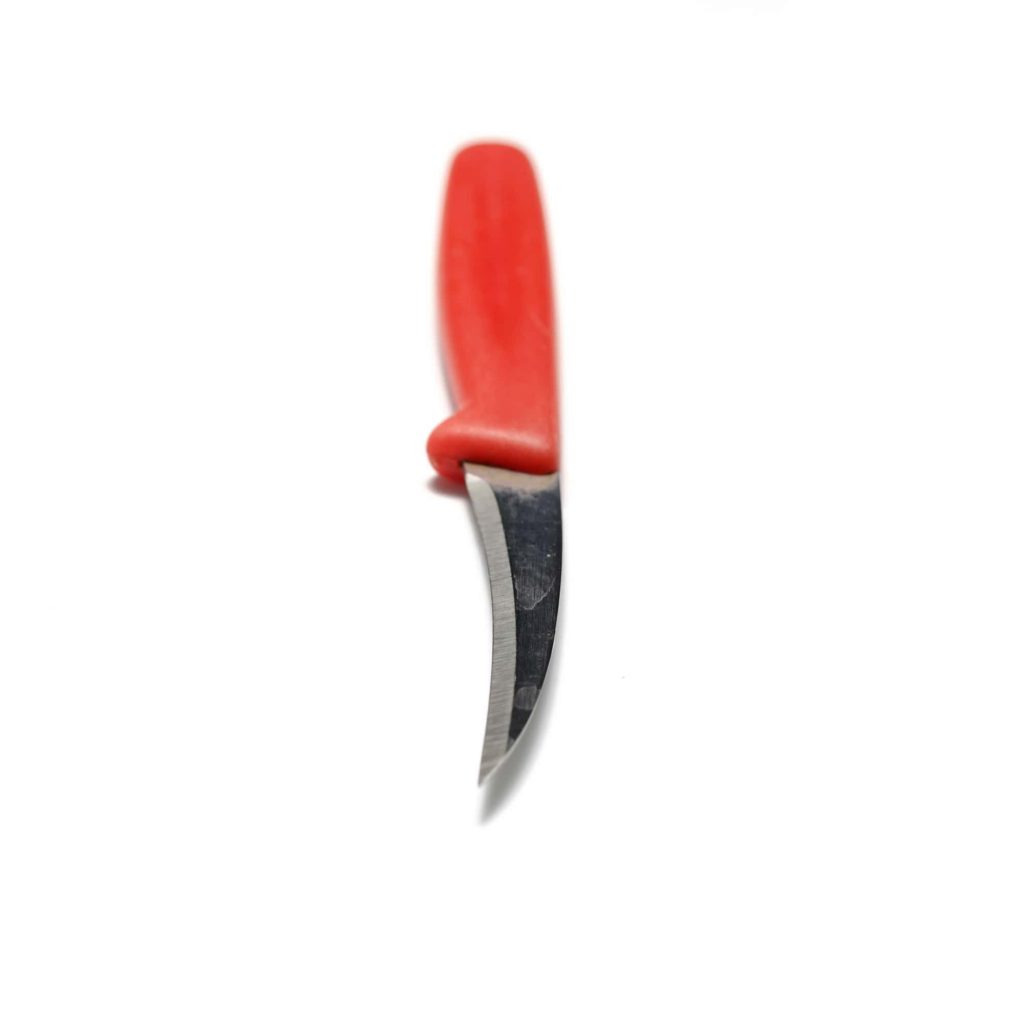
Most home cooks have not heard of a bird’s beak paring knife because it was historically used in the French culinary system. The knife features a small curved blade shaped like a bird’s beak and is intended for tasks that don’t involve a cutting board. Its original purpose was to turn vegetables into seven-sided barrels, a classic French technique.
Most cooks use a bird’s beak paring knife for peeling fruits and vegetables and precise cutting work such as trimming brussels sprouts or removing parts of a potato. Bird’s beak blades are, on average, one inch shorter than a standard paring knife, making it easier to control when making tiny incisions without a cutting board. The blade also allows you to be more nimble around irregularly shaped foods, such as lemons and ginger, because of the crescent shape. Overall, this blade is amazing for small details.
However, a bird’s beak blade will not replace a spear point paring knife because it’s not as versatile. It is not meant to be used on a cutting board and can’t make precise straight cuts that are needed for cutting blocks of cheese or cutting pockets into pork chops. It is also a lot harder to sharpen with an electric knife sharpener because of the rounded blade. If you already have a spear point paring knife and are looking for a knife that has a more defined purpose, this one is perfect for you.
Sheep’s foot paring knife
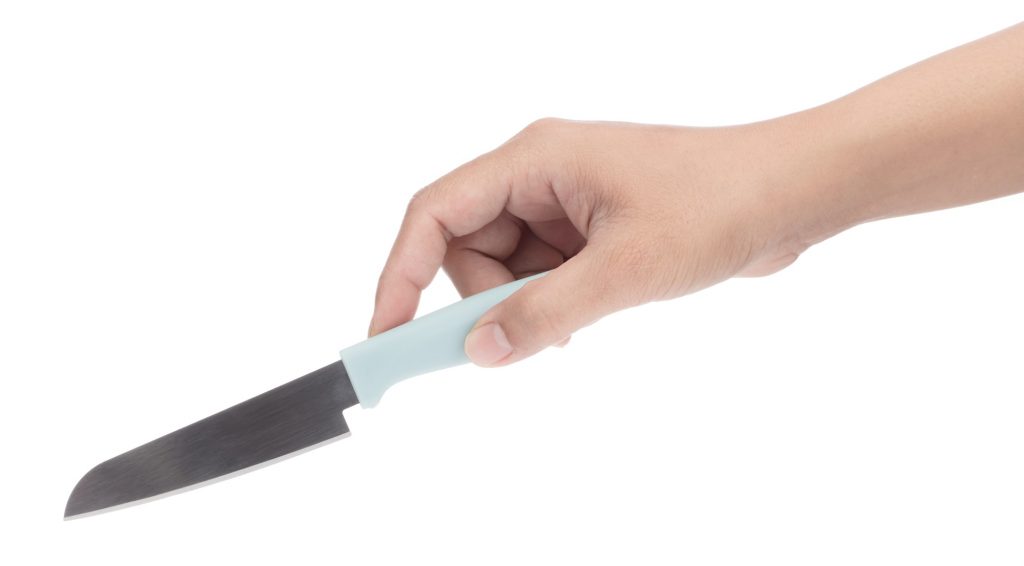
A sheep’s foot paring knife resembles a smaller version of a Santoku knife. It has a blunt tip and a straight edge blade to maximize cutting contact with food. The shape of the blade is best used with a cutting board because you can lean the entire length of the blade against the cutting board and only the point of the blade will touch the board during the chop. This results in straighter and more precise cuts with minimal hand movement.
A sheep’s foot paring knife is best used to cut soft and hard cheeses, and julienne cutting – cutting vegetables and fruits into long thin strips. It’s also great for slicing and dicing small foods like garlic, shallots, and celery. As an added bonus, it’s hard to cut yourself with the tip of the blade because sheep’s foot blades have a rounded tip.
Unfortunately, the rounded tip makes this knife less versatile than the spearing point. You’ll have a harder time piercing foods and coring fruits, making this knife limited in its abilities. If you are looking to add a new paring knife to your collection, this one is for you. If you are looking for one paring knife that can do it all, you may run into some difficulties with the sheep’s foot blade.
Western-style Japanese paring knife
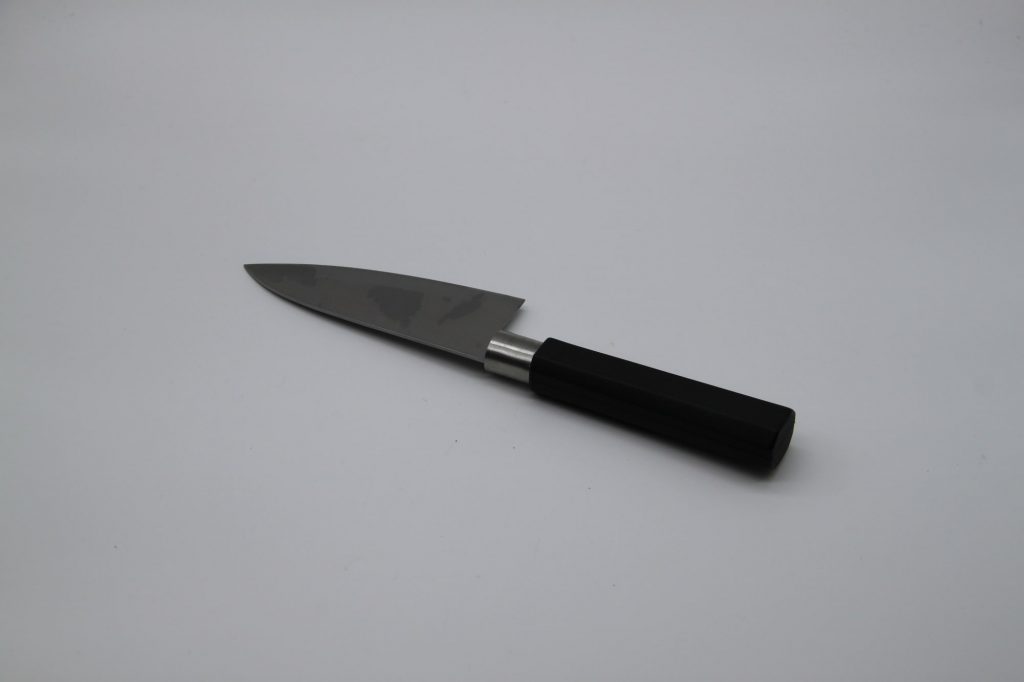
The Western-style Japenese paring knife is shaped like a spear point paring knife with a less-curved blade and a longer blade length, varying from 3.5 to 8 inches. It is usually made with harder steel that creates a much sharper edge.
The Western-style Japanese paring knife is best used for intricate cutting and carving, decorative garnishing, and as a utility knife to prepare foods. This style of blade gives you great control over what you’re cutting when using a cutting board. It’s also razor-sharp, making slicing and dicing a breeze.
Due to the straighter blade design, the Western-style Japanese paring knife is better for mini chopping duties on a cutting board. The blade is also longer than the spear point blade, which makes it harder to complete handheld tasks where precision and control are required. Additionally, the material of the blade, carbon steel, makes this knife more expensive than the other blades mentioned. It is the best alternative to a conventional spear point blade and is quite versatile in comparison to the bird’s beak and sheep’s foot blades.
Blade Material – What material should a paring knife blade be made of?
There are various materials a paring knife can be made of, including stainless steel, carbon steel, and ceramic.
Most home cooks choose paring knives that are made with stainless steel. This is because stainless steel is resistant to rust and corrosion, low maintenance, and incredibly sharp. Stainless steel knives may also have a layer of chromium oxide that prevents oxidation and rusting so they are less work to care for. However, your knives will need to be sharpened frequently.
Carbon steel blades are often chosen by professional chefs because they have unmatched performance. When carbon steel knives are freshly sharpened, they are sharper than stainless steel and stay sharper longer. However, caring for them is more difficult and they must be washed and dried shortly after use to prevent discoloration and rust. If not cared for properly, carbon steel is vulnerable to staining and rusting. Some also say that carbon steel can create a “metallic” taste with acidic foods, although over time and use this may reduce.
Ceramic knives are made from zirconium oxide and are becoming increasingly more popular. The material is hard, durable, and able to retain a sharp edge for a long time. Ceramic knives are extremely lightweight, making them a great material for paring knives, but because of it’s brittle nature, they are likely to chip or break if dropped. However, the sharp edge allows ceramic knives to cut and peel fruit without bruising or browning it prematurely. Unfortunately, ceramic knives do require a specific ceramic knife sharpener but it does stay sharp for a long time so it will need to be sharpened less frequently than stainless steel.
Ultimately, every material has some disadvantages so it comes down to what you want from your knife and what you are willing to sacrifice. For example, a sharp carbon steel knife comes with very specific care instructions, or a ceramic knife is sharp but can easily chip. In the end, all three materials will help you get the final result you want.
Blade Length – How long should the blade of a paring knife be?
Most pairing knives range between 2.5 – 4 inches in length, while a Western-style Japanese paring knife varies from 3.5 to 8 inches. The bigger the blade does not always mean it’s better. The shorter the pairing knife, the more control and precision you have when peeling or slicing vegetables and fruits by hand. For example, a bird’s beak knife is usually around 2.75 inches because it has a concave blade that is meant for trimming and peeling. Anything that involves you holding the item in one hand and using the other hand to peel or slice, is better with a shorter blade. A longer blade will give you better control on a cutting board where you can use the length of the knife to cut straight lines with less pressure and precision. The length of the blade you choose will depend on how you plan to use your knife.
Blade Height/Width – How high/wide should the blade of a paring knife be?
The width of a blade affects how well the blade can cut. The thicker the blade, the stronger it is. The thinner the blade, the easier it will be for slicing. The average width of a paring knife is about 0.75 inches wide which allows you to have some flexibility and precision in the blade when you cut. Overall, the thickness of a paring knife is very minimal and isn’t a deciding factor when choosing a knife.
The height of the blade depends on the use case of your paring knife. If you’re looking for a knife that you can use to peel fruits and vegetables, you want a shorter height. This is because you want to be able to control the blade and have your thumb or index finger as close to the sharp edge as possible to maneuver the knife. Again, the use case of your knife will determine the best height for you. It comes down to personal preference for width and height.
Blade Flexibility – Should a Paring Knife have a flexible blade?
The flexibility of the blade plays an important role in a paring knife. The flexibility is measured by how much pressure can be put on the knife before it snaps. The degree the blade is bent is recorded as the flexibility of the knife. This goes hand in hand with the thickness of the blade. The less thick a blade is, the easier it will be to snap. Overall, a paring knife should have some flexibility so the blade can maneuver into tiny spaces and conform to curves for a cleaner cut. It should have more flexibility than a chef knife, which is required to cut harder fruits and vegetables with more force. Overall, some flexibility is required in a paring knife but not so much flexibility that the knife seems flimsy and easily breakable.
Tang for Paring knife
Stainless steel and carbon steel knives include a tang. A tang is the part of the knife blade that extends into the handle. How far it extends depends on if the knife has a full or partial tang. A full tang is when the steel from the blade extends into the handle to make one single piece of metal. The weakest part of a knife is the point of attachment so having one long piece of steel means there is no area of potential weakness. It allows you to apply more force while cutting without worrying that the knife will break away from the handle. It is more expensive to purchase a full tang knife because it requires more stainless steel or high carbon steel.
A partial tang only extends part of the way into the handle – it can be referred to as a part of a three-quarter tang knife. It’s a budget-friendly alternative if you are not concerned about stressing the knife and snapping the blade. If you are using your paring knife to chop herbs or slice soft fruits, a partial tang is fine and allows you to have a lighter overall weight.
When considering if you need a partial or full tang for your paring knife, it comes down to your use case. If you’re going to be chopping harder vegetables or putting pressure on the handle of your knife, a full tang is important. Think about the pressure you’d put on a chef knife to cut a watermelon – you’d want something sturdy that wouldn’t snap. However, most use cases of a paring knife involve you using the knife in your hand to peel or slice. For that reason, a partial or three-quarter tang is enough for most home cooks.
HRC for a paring knife
HRC is the Rockwell Hardness Rating (HRC) and the numbers determine a material’s ranking on the scale. The higher the HRC number, the harder the material and the more pressure is required to indent a surface. Anything below an HRC52 is too soft to be used as a kitchen knife blade. A good range for a paring knife for the average home cook is between HRC52 – HRC54, making it soft but reasonable for an inexpensive kitchen knife. However, there are trade-offs between harder and softer ratings. The harder the knife, the longer it holds a sharp edge but it’s more difficult to hone, something we talk about later on in this article. Also, harder knives are more prone to chipping because the hard steel makes the knife brittle. The softer the knife, the more durable it is but it will remain sharp for less time. Although you want a paring knife to remain sharp, it’s a personal preference if you are willing to handle the brittle nature of a harder knife blade.
HRC is important to help differentiate between knives and measure quality, but we wouldn’t say it’s the deciding factor for a pairing knife. If you are choosing between two knives it’s more important to go with a knife that is the best material and size for your use case.
Should a Paring Knife be Forged or Stamped?
When you are shopping for steel knives, you may read that a knife is forged or stamped.
A forged knife is made from a single bar of steel, which is heated and then pounded into a shape – either by a machine or a craftsman. To identify a forged knife, look at the bolster, the wide lip that connects the blade and handles together. A forged knife usually includes a partial or full tang, making it heavier, thicker, and more balanced in your hand. It also tends to be harder and holds a sharper edge better than a stamped knife. Although the labor-intensive process to create a forged knife means these knives are usually higher in price.
A stamped knife is when a blade is “stamped” or laser cut from a large sheet of steel and then honed and heat-treated for durability. Stamped knives are thinner, lighter, less expensive, and more flexible. However, they can lose their sharp edge a lot faster, meaning they’ll need sharpening a lot quicker with a greater risk of the handle breaking.
Overall, the decision to go for a forged or stamped knife is a personal preference. If you are looking for a paring knife that you will use daily, the additional maintenance of a stamped knife may be frustrating and tedious for you. However, if you want something lightweight, flexible, and cheaper, a stamped knife is perfect for you. The decision comes down to your use case, frequency, and budget.
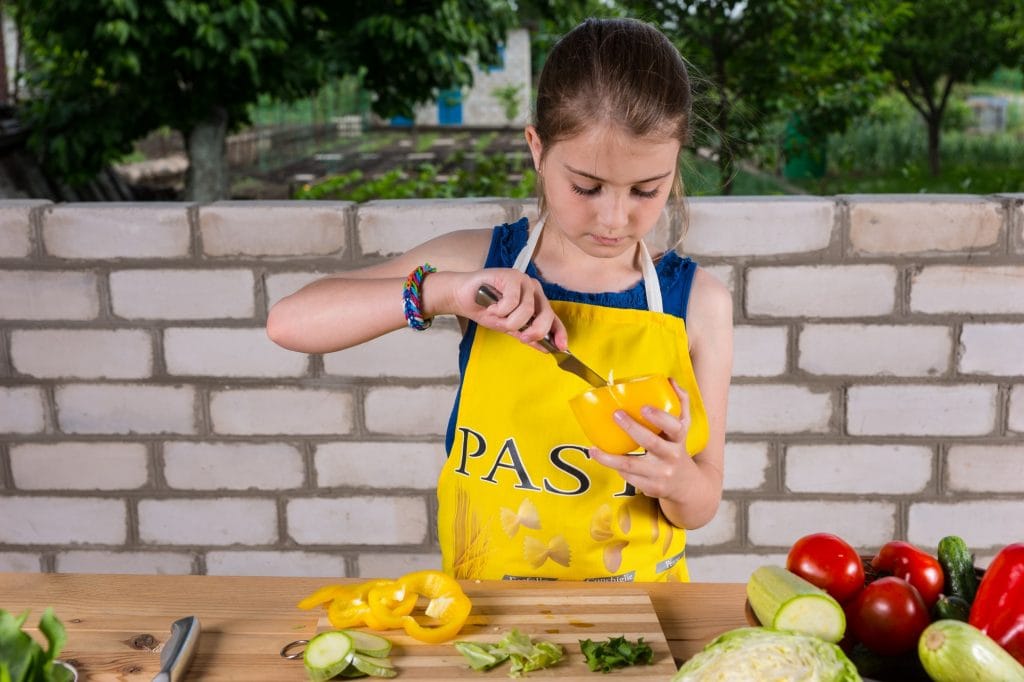
The Paring Knife Handle
The handle is the part of the knife that you hold and use to guide the blade to cut, slice, dice, or peel.
There are 5 main parts of a handle:
- Bolster, the part of the blade that meets the handle. The bolster is a thin area that provides balance for the knife and also helps protect your hand from getting in the way of the blade. A sloped bolster is extremely important for a paring knife because it allows you to apply lots of pressure on the blade without endangering yourself or your knife. It also allows for a more effective grip, specifically a pinch grip, that can give you more precision when cutting since your hand can get closer to the blade without hurting yourself.
- Tang, the unsharpened part of the blade that extends into the handle of the knife. As explained earlier, a knife can either have a full or partial tang. The purpose of the tang is to give the knife added stability and weight.
- Scales are the material that makes up the knife handle. This is the part of the knife that you’ll use to grip. The most common materials that make up the scales are are either wood, plastic or stainless steel and we go into the pros and cons below.
Plastic is the most popular handle because it’s harder, denser, more durable, and lasts longer than wood. It’s easier to clean but can be slippery when wet which makes it harder to grip when cleaning or cutting. This can be fixed by finding a rubberized plastic handle which is softer and more comfortable to grip for long periods of time.
Wood offers the most variety because it can be carved into different shapes and comes in different shades. Wood is strong and stable, without contracting in extreme temperatures. However, it is becoming less common because of food safety concerns – wood can trap bacteria in the handle. It also can’t be washed in the dishwasher and may start to splinter over time if it’s used frequently.
Stainless steel is durable and easy to maintain. It’s a smooth surface that is prone to slipping especially if your hands are wet. To counteract the smooth texture, some metal knives come with a textured design or brushed satin for better grip. The handle is usually hollow to make the handle lighter and easier to hold and use.
Similar to the blade materials, choosing a handle material comes down to personal preference. If you want a more aesthetic knife, go with a wood handle. But if you want something practical, sturdy, and inexpensive, plastic is a good alternative. - Rivets, the rivets are the metal pins that join the scales to the tang to form the shape and style of the handle. Rivets are usually design-based and can be visible or hidden depending on the style.
- Butt, the end of the handle of the knife. The butt can either be rounded, straight or angular. A rounded butt is the most aeshetic but the least practical because it makes it harder to get a sturdy grip for a precise cut.
Overall, when reviewing the type of handle you want, it’s important to consider an oval or D-shaped handle because it’s easier to grip and stay comfortable for a long period of time. A thick handle will give you a better grasp because it will fit into the fist of your hand so you are less likely to lose control or feel the handle of the knife slip from your hand. Lastly, you want to have a balanced knife that feels comfortable in your hand to make cutting a breeze. This article will go into more detail on how to find the right balance for an ergonomic grip further below.
Balance – What’s the right balance for a Paring knife?
Balance differs from person to person because of your usage, gripping preference, and knife style. To determine your balance point, you need to know where you naturally hold or grip the knife.
There are three types of grips that affect your balance point.
- Pinch grip: your thumb and index finger determine the balance, and you are either pinging the knife at the blade, bolster, or handle area.
- Thumb grip: you place your thumb at the top of the handle and your index finger determines the balance point of the gripping style.
- Fingertip grip: your index finger is on the blade and your thumb and middle finger determine the balance point.
When choosing a paring knife, pick one with more weight in the handle than in the blade. This is because a paring knife requires control and precision. By having slightly more of the weight in the handle, you’ll have an easier time gripping and maneuvering the blade.
Maintenance and Care – How to maintain a Paring Knife?

Maintaining your paring knife is important to lengthen the longevity of your knife. Some materials involve more immediate and strict cleaning regimens but provide a sharper cut. Finding the right balance of convenience vs. maintenance will come down to personal preference. This article goes into more detail below on the materials and the impact they can have on your decision.
How to clean a paring knife?
All paring knives can be cleaned using warm water and mild soap, regardless of the material.
Ceramic knives are the easiest to clean because they don’t oxidize or corrode. All you need to do is pass it under running warm water and use a mild soap and sponge to clean the surface to prevent food buildup that can dull the blade. Be gentle with a ceramic knife because it’s a brittle material that can easily chip if enough pressure is put on it when cleaning.
Stainless steel is the second easiest to clean but requires more work. Stainless steel knives cannot air dry because air drying them may cause slight oxidation. You need to use a mild soap and sponge to remove food buildup that can dull the blade and wipe it immediately to limit exposure to moisture. Avoid harsh soaps with strong chemicals because over time they can cause your stainless steel knife to lose its shine and get dull.
Carbon steel knives are the hardest to clean because they can never be soaked in water and you must avoid adding them to a dishwasher. Carbon steel is highly prone to rust and too much exposure to moisture will promote rust and oxidation. It’s best to immediately wipe down the knife with a soft cloth to remove food particles, this is especially important with acidic foods that can promote oxidation. To remove food particles from the knife, you can also use warm water and mild soap. Remember to dry the knife immediately to prevent prolonged exposure to moisture.
Are paring knives dish-washer safe?
Paring knives should never go in the dishwasher because the abrasive detergent, high heat, and jostling with other dish items can cause them to dull prematurely.
Ceramic paring knives are brittle and can be jostled or collide with other items that can chip the blade. It’s best to follow the cleaning instructions we listed above to help your ceramic blade last.
Stainless steel knives can oxide slightly over time and should be dried immediately. Leaving a stainless steel knife in the dishwasher with abrasive detergent and high heat can cause the blade to prematurely rust and dull.
Carbon steel knives are very sensitive and adding them to the dishwasher can cause them to stain from the abrasive detergent, high heat, and prolonged exposure to moisture. They need to be cleaned by hand and dried immediately. If stains and rust form on your knife, soak the knife in white vinegar for 15-30 minutes, however, they should be immediately rinsed and wiped dry.
Also, keep in mind that plastic and wood knives can crack and loosen over time if they are added to the dishwasher. For the maintenance of your handle and blade, it’s best to hand wash your paring knives.
There are a few knife sets that are advertised as suitable for the dishwasher. An example of these sets is the Victorinox Swibo series or the SwissClassic knives. However, knives are sensitive to dulling in the dishwasher and many companies that have dishwasher safe knives will suggest hand washing them if you want to prolong the life of your knife.
Learn how to remove rust from a knife blade and how to protect your kitchen knife from rusting.
Honing & sharpening your knife, How to keep your paring Knife Sharp?
There is a difference between honing and sharpening your steel knife. Every time you use a knife, the edge gets bent out of shape and can lead to a dull knife that is imprecise and less efficient. You can fix this by honing a knife with a steel rod that straightens out the cutting edge on the blade to create smoother and safer cuts. You can hone your knife weekly or every time you use your knife. How many times you hone your knife depends on how often you use it and how razor-sharp you want the edge to be.
Sharpening your knife makes your knife sharper. There was no better way to say that. There are a couple of ways you can sharpen your knife. The first is with a whetstone, also called a water stone or sharpening stone. This is a rectangular block that works like sandpaper to straighten and refine the edge of the blade as you slide your knife against it. Most whetstones are meant to be soaked in water but make sure to read the user instructions before to ensure it’s necessary. If it needs to be submerged, soak it in water for 5-10 minutes until it stops producing bubbles. This will make sure the surface of the stone is smooth and the blade does not catch nicks that can cause the blade to be uneven. To use, hold the knife at a 12-18 degree angle against the whetstone and gently drag each side of the knife against it a few times. This lower angle is okay for a paring knife because it’s durable and can handle the sharper angle without chipping. Start with a coarse grind if your knife is especially dull and repeat the process on the fine-grind side.
The second way to sharpen your knife is with a knife sharpener. This is a quick-fix solution for dull knives – just press the blade of the knife into the coarse side and then the fine side. A knife sharpener is an easier way to sharpen your knife but it’s also more abrasive. Considering the paring knife is pretty durable, we don’t think it’s a concern for you to use a knife sharpener. We suggest sharpening your knife every couple of months or at least once a year depending on your use and how soon you notice that honing doesn’t improve your ability to make clean slices.
Read now >> How to tell if a knife is sharp?
How to store a paring Knife?
Properly storing your knives is extremely important to prevent them from rusting, dulling, chipping, or cutting you. The easiest storage solution is a knife block where the knife snuggly fits into a block slot and does not jostle or rust over time. It provides good protection to the edge of your blades and can extend the longevity of your knives. The disadvantage is that the wooden block takes up valuable counter space and the slots may not fit perfectly with the size of your knife. It can also be hard to sanitize as moisture and crumbs can be caught in the slots so if you use a knife block. If you decide to get a knife block, be diligent about cleaning and drying your knives prior to storing them.
The second storing option is a mounted magnetic knife strip. This option allows you to preserve your countertop space while also making sure your knives are within reach. However, the impact of your blade on a bar can scratch your knives – which does not affect the functionality but can be an eyesore. You should also consider safety if you have small children or pets that can jump on the counter and touch the sharp points of the knife.
A third storage option is a magnetic knife stand, which is smaller than a wooden block and includes the ease of a magnetic strip. However, your blades are still left uncovered and can be dangerous to small kids and pets. It also takes up space on the counter, which may be valuable space for you.
The last option is to store your knives in a drawer. To store knives in your drawers, you need adjustable slide-in inserts or sheaths that perfectly fit your paring knife. You must make sure your knives tightly fit because any jostling can cause the blade to dull over time.
All these options are great and it depends on your personal preference, family dynamics, and counter space for what will work best in your home.
The best and most reliable chek knife Brands
Choosing a paring knife can be overwhelming and we’ve given you a lot to consider. To narrow your choices, it may be easier to start by reviewing reliable and well-known knife brands that cater to most use cases. Here are our top 5 suggestions for reliable brands.
- Victorinox
Victorinox is an affordable knife brand known for its multi-purpose knives. They make blades out of stainless steel known as martensitic, which is a blend of carbon, chromium, and molybdenum. The mix of steel creates a blade that is corrosion-resistant, hard, and durable. The handles are either wood or synthetic, depending on the collection and most of the handles are ergonomically designed for the best grip. The prices of a paring knife can range from a beginner paring knife at $5.99 to $72.99 for their advanced paring knife made with full tang. Pricing depends on the store and your location. - Henckels International
Henkels International is one of the largest and oldest manufacturers of kitchen knives. The company offers forged and stamped knives with the majority of their knives stamped with high-quality stainless steel. They also create handles made of super durable and include moisture-resistant plastic that is ergonomically designed for comfort. Pricing for a paring knife can range from $10.99 to $44.99 depending on the store and your location. - Mercer Culinary
Mercer Culinary is a well-respected brand that has a variety of lines ranging from professional-grade to inexpensive. The knives cater to a wide variety of chefs and the handles are comfortable to almost everyone. The brand presents the best combination of equality and affordability for beginner to intermediate cooks with a forged stainless steel finish and ergonomic handles. Paring knives can range from $4.79 to $18.99 depending on the store and your location. - Dalstrong
Dalstrong knives are every bit as high quality as the name brand but with a lower price. They provide a good option for home chefs looking to build their knife collection, with a stainless steel blade and wood or resin handle. The type of steel ranges by collection, depending on your price range and use case. Prices range from $39.99 to $79.99 depending on store and location. - Shun
Shun knives are manufactured by hand and forged using Japanese methods. The blades are made with high-quality steels that are capable of holding an incredibly sharp edge. The handles are made with PukkaWood, a composite of hardwood and resin, to provide the natural beauty of wood with the durability of synthetic material. Paring knives range from $69 to $113 depending on store and location.
Conclusion
When choosing a knife, remember that it all comes down to what feels best for you. A paring knife that your fiend or favorite chef swears by may not be right for you.
Start off by considering what you are looking to achieve with your paring knife. If you want one, all-rounded knife, a spear point blade is your best option. If you want a blade that is best used for chopping food on a chopping board, the longer blade of the Western-style Japanese paring knife is perfect for you. If you want a less versatile but more specific knife, look at the bird’s beak and sheep’s foot blade.
When it comes to the material of the blade and handle, there are pros and cons to both. Consider what your must-have features in a knife are and what you aren’t willing to compromise. This will help you narrow your decision. For example, if you want the sharpest knife that you rarely have to sharpen, go for a carbon steel knife.
Lastly, consider the fit of the knife. Find a knife with a handle that comfortably fits in your fist. You want to feel in control of the knife to make sure you’re getting precise cuts in the kitchen.
The good thing is that there are no right or wrong answers to choosing the best knife. All that matters is that you enjoy the paring knife and feel good about the decision you made.
Read now >> Utility Knives VS Paring Knives
